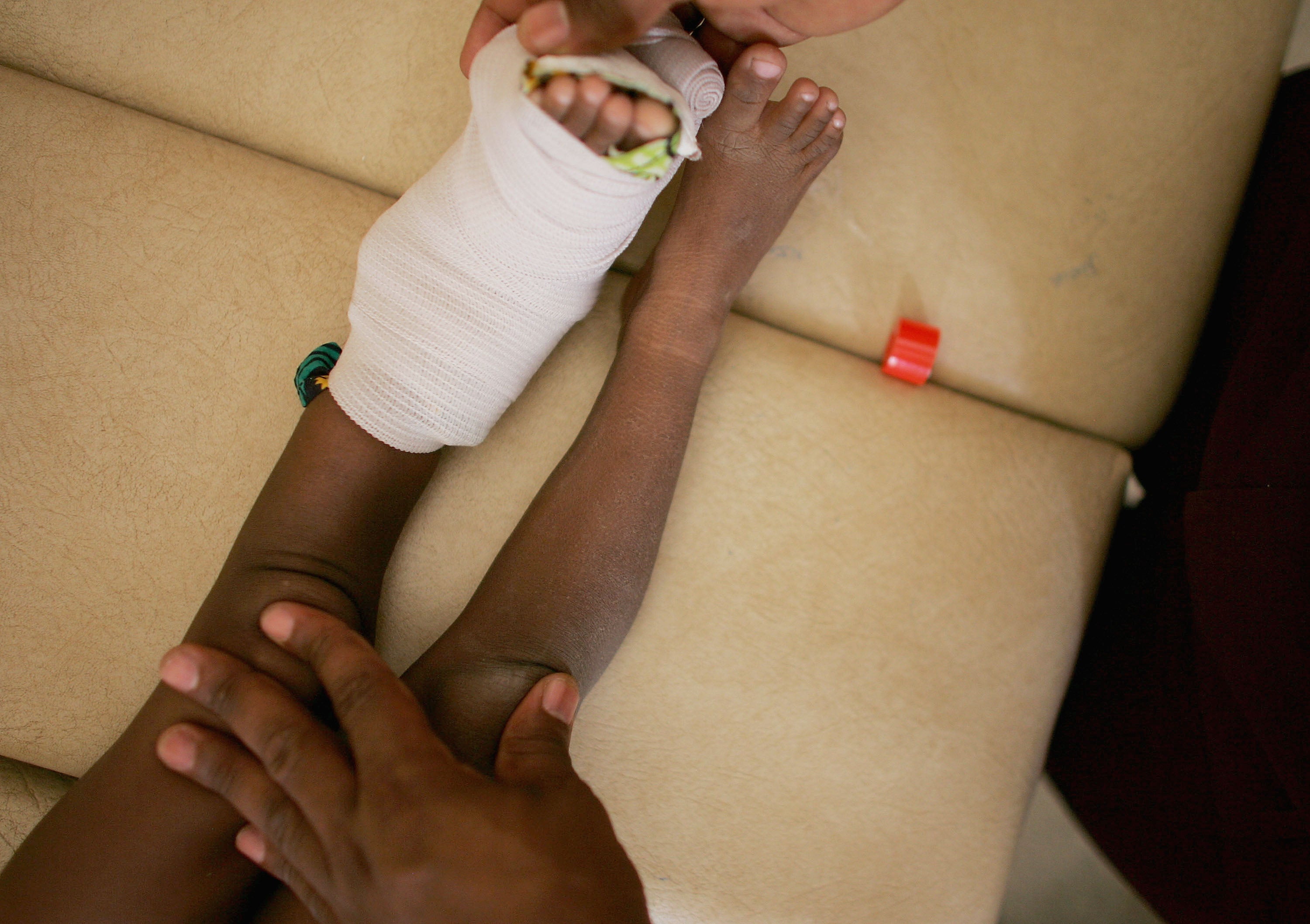[responsivevoice_button rate=”1″ pitch=”1.2″ volume=”0.8″ voice=”US English Female” buttontext=”Story in Audio”]
Two Strains of Polio Down, One to Go

Editor’s Note (8/25/20): This article is being republished today in light of the news that Africa is expected to be declared free of wild polio. The achievement comes after decades of vaccination drives succeeded in driving the virus out from its last foothold in Nigeria.
In January 2014 an American public health worker was visiting northern Nigeria to observe a polio prevention campaign by local health workers. It was a big, festive event with a marching band to bring out parents and children for their immunizations. But the American visitor and the local program manager soon found themselves being drawn away from the action, down deserted streets to an area still under construction. They were being led by a young girl.
“And what was happening was that she was bringing us to her house,” recalls John Vertefeuille, now chief of the polio eradication branch at the U.S. Centers for Disease Control and Prevention. “She had a baby brother born the night before, and the father brought out the baby, and we were able to vaccinate him. She was so excited to be able to give her new brother that gift. She probably didn’t comprehend it, but she had given that child the possibility of a life without polio. What an incredible thing it will be when we can do that for every child, from here until the end of time.”
The international effort to achieve this goal passed a major milestone this week with the worldwide eradication of wild poliovirus type 3. The announcement, due Thursday from the Global Commission for the Certification of the Eradication of Poliomyelitis comes just four years after eradication of wild poliovirus type 2. It leaves only a single strain, wild poliovirus type 1, on the loose. Type 1 is now holed up in the smallest area in the history of the disease—though that area comprises politically and geographically fraught regions of Pakistan and Afghanistan.
The current target for worldwide eradication is 2023, according to the Global Polio Eradication Initiative (GPEI), a multinational partnership that has been pursuing this goal since 1988. Polio would be only the second human disease to be wiped out globally, after smallpox in 1980.
Credit: CDC
The 2023 target is ambitious. It would mean seeing the world’s last cases of wild poliovirus sometime next year—down from 88 cases so far in 2019—followed by a minimum of three years of intensive monitoring to certify eradication. But the antipolio effort has a recent history of success against long odds. India, where polio was paralyzing 500 to 1,000 children per day in the 1990s, eliminated the disease in 2014. The wrenching spectacle of child polio victims begging in that nation’s streets, with their twiglike legs folded beneath them, is now history.
Nigeria, where antigovernment gunmen assassinated nine women polio vaccinators in 2013, has now gone three years without any evidence of wild poliovirus—and seven years without type 3—largely through the heroic persistence of community health workers. Success there, says Carol Pandak of Rotary International, means the entire African continent could be certified free of all three strains of wild poliovirus sometime next year.
As the last two countries reporting wild poliovirus, Pakistan and Afghanistan are now feeling “tremendous global pressure to get the job done,” Pandak says. The Taliban had suspended the vaccination campaign early this year in parts of Afghanistan under its control, but last month it reversed itself and allowed polio immunizations to resume in clinics—though not in mosques or door-to-door. In neighboring Pakistan the government of Prime Minister Imran Khan recently made eradication its top priority, with Khan to assume leadership of the campaign starting next month.
But GPEI, led by the World Health Organization, the CDC, the United Nations Children’s Fund, Rotary International and the Bill & Melinda Gates Foundation, also faces daunting obstacles. The most alarming of them is the emergence and spread of vaccine-derived type 2 poliovirus, mainly in Africa. Public health workers have recognized the problem since 2000, according to Walter Orenstein, an infectious disease and polio specialist at the Emory University School of Medicine. The live but attenuated, or weakened, virus used in the Sabin oral vaccine (which is the mainstay of eradication campaigns) can sometimes spread from a vaccinated child to someone who is still susceptible to polio.
This transmission most commonly happens, Orenstein says, when a vaccine recipient is shedding the weakened virus in feces and inadvertently passes it to a susceptible person via interpersonal contact or a drinking-water source. In the subsequent chain of infection from person to person, the virus may mutate in the human body into more virulent and transmissible forms—and begin to circulate like a wild poliovirus among unvaccinated children. Last year vaccine-derived poliovirus outbreaks caused 105 cases of paralysis in children, according to GPEI.
So far, though, there has not been any way around reliance on the oral vaccine in eradication efforts, Orenstein says. The inactivated vaccine administered by injection is highly effective at protecting individuals by inducing humoral immunity (in the blood and other bodily fluids), he says, but it is not so good at inducing intestinal immunity. That makes it less useful in areas with poor sanitation, where accidentally ingesting fecal matter from drinking water is a hazard. The oral vaccine is not only easier and less costly to use in large-scale door-to-door campaigns; it also confers stronger intestinal immunity and, in the vast majority of cases, helps protect the community by reducing the amount of the virus shed in human waste.
Researchers have now identified the key points on the oral vaccine’s genome where mutations can cause it to revert to a more virulent form. That achievement has made it possible to introduce genetic modifications at those points to prevent reversion, says Jay Wenger of the Gates Foundation, which has funded the effort. Two new oral vaccine candidates with these modifications have advanced to testing for emergency-use regulatory approval by the World Health Organization and the affected countries, and they could be available as early as June. That timeline still leaves a critical eight-month window, however, in which a vaccine-derived outbreak could occur.
Another potential obstacle is fatigue at the international donor level. “We know that the last mile has proved to be the toughest phase of eradication,” says Michel Zaffran, director of polio eradication for the World Health Organization. People tend to become complacent as the success of a vaccine leads them to forget just how dreadful the disease can be. GPEI is now seeking $3.27 billion for its next four years of work, with a donor “pledging moment” scheduled for November 19 in Abu Dhabi.
“It’s always a challenge to ask for more money—especially for a disease that, for many people, no longer exists,” Zaffran says. “People ask, ‘Why is it costing so much to eradicate polio when you have so few cases left?’ But eradicating polio and stopping these outbreaks means we have to vaccinate 400 million children every year”—and then continue to vaccinate children for at least another 10 years—“to ensure there is no reemergence of the disease.” It also requires a sophisticated network to check samples from individual patients, sewage systems and open water bodies for any sign of the virus.
Fatigue at the levels of the community and individual parents could be an even greater challenge. In areas with poor sanitation, children sometimes need eight to 10 doses of vaccine to achieve immunity. Polio vaccinators have continued working to reach those children, despite recent assassinations in Pakistan. But parents naturally wonder why public health workers keep coming back to them with polio vaccine when families still lack clean water, basic sanitation or access to general health care. That situation has required the polio eradication effort to broaden its focus to other community needs and to persuade local political and religious figures to become leaders of the campaign.
Would it be more practical just to back off from the difficult goal of eradication and instead focus on merely controlling the spread of the disease? Zaffran cites a 2007 study calculating that the switch from eradication to control would cost $3.5 billion annually—and result in 200,000 cases of polio every year. “If we stop,” he says, “the disease will come back. It will rapidly spread into the Middle East, into Africa and maybe even into Europe and the United States, as we have seen with measles. I truly believe that now is the time to finish the job—and we have all the tools to do it.”




























